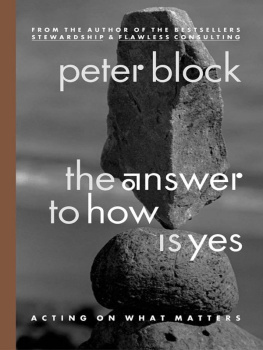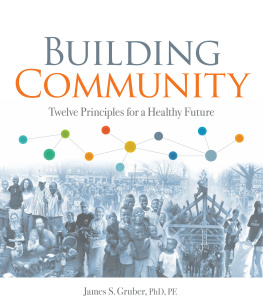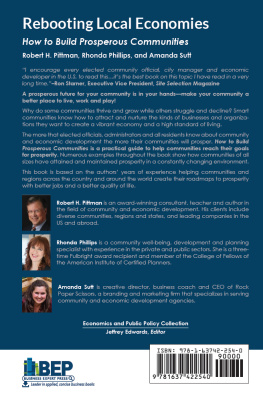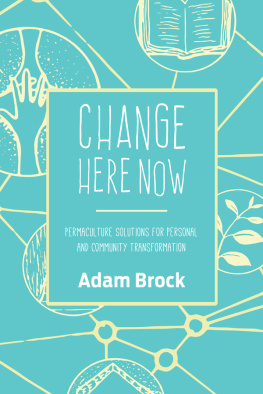COMMUNITY
ALSO BY PETER BLOCK
The Answer to How Is Yes: Acting on What Matters
Flawless Consulting:
A Guide to Getting Your Expertise Used, rev. ed.
The Flawless Consulting Fieldbook and Companion:
A Guide to Understanding Your Expertise
Freedom and Accountability at Work:
Applying Philosophic Insight to the Real World, coauthored by Peter Koestenbaum
Stewardship: Choosing Service Over Self-Interest
The Empowered Manager:
Positive Political Skills at Work
COMMUNITY
The Structure of Belonging
PETER BLOCK

Community
Copyright 2008 by Peter Block
All rights reserved. No part of this publication may be reproduced, distributed, or transmitted in any form or by any means, including photocopying, recording, or other electronic or mechanical methods, without the prior written permission of the publisher, except in the case of brief quotations embodied in critical reviews and certain other noncommercial uses permitted by copyright law. For permission requests, write to the publisher, addressed Attention: Permissions Coordinator, at the address below.

Berrett-Koehler Publishers, Inc.
235 Montgomery Street, Suite 650
San Francisco, California 94104-2916
Tel: (415) 288-0260, Fax: (415) 362-2512
www.bkconnection.com
Ordering information for print editions
Quantity sales. Special discounts are available on quantity purchases by corporations, associations, and others. For details, contact the Special Sales Department at the Berrett-Koehler address above.
Individual sales. Berrett-Koehler publications are available through most bookstores. They can also be ordered directly from Berrett-Koehler: Tel: (800) 929-2929; Fax: (802) 864-7626; www.bkconnection.com
Orders for college textbook/course adoption use. Please contact Berrett-Koehler: Tel: (800) 929-2929; Fax: (802) 864-7626.
Orders by U.S. trade bookstores and wholesalers. Please contact Ingram Publisher Services, Tel: (800) 509-4887; Fax: (800) 838-1149; E-mail: customer.service@ingrampublisherservices.com; or visit www.ingrampublisherservices.com/Ordering for details about electronic ordering.
Berrett-Koehler and the BK logo are registered trademarks of Berrett-Koehler
Publishers, Inc.
First Edition
Hardcover print edition ISBN 978-1-57675-487-0
PDF e-book ISBN 978-1-57675-773-4
2008-1
Developmental editor: Leslie Stephen
Production, interior design, and composition: Leigh McLellan Design
Copy editor: Elissa Rabellino
Cover designer: Bookwrights/Mayapriya Long
To Maggie
In appreciation for your commitment, intelligence, love, and integrity that make what I do possible. You are a placeholder for all who give their talents and love in support of others. Plus, you got the point of it all: You have chosen adventure over safety. This, in itself, is a rare gift.
Contents
CHAPTER 15 The End of Unnecessary Suffering
Role Models and Resources
The first human who hurled an insult
instead of a stone
was the founder of civilization.
Sigmund Freud
Welcome
This book is written to support those who care for the well-being of their community. It is for anyone who wants to be part of creating an organization, neighborhood, city, or country that works for all, and who has the faith and the energy to create such a place.
I am one of those people. Whenever I am in a neighborhood or small town and see empty storefronts, watch people floating aimlessly on the sidewalks during school or working hours, pass by housing projects, or read about crime, poverty, or a poor environment in the places where our children and our brothers and sisters live, I am distressed and anguished. It has become impossible for me to ignore the fact that the world we are creating does not come close to fulfilling its promise.
Along with this distress comes the knowledge that each of us, myself included, is participating in creating this world. If it is true that we are creating this world, then each of us has the power to heal its woundedness. This is not about guilt, it is about accountability. Citizens, in their capacity to come together and choose to be accountable, are our best shot at making a difference.
This book is for all who are willing to take a leadership role that affirms the conviction that without a willingness to be accountable for our part in creating a strong and connected community, our desire to reduce suffering and increase happiness in the world becomes infinitely more difficult to fulfill. It is also based on the belief that in some way the vitality and connectedness of our communities will determine the strength of our democracy.
Community as used here is about the experience of belonging. We are in community each time we find a place where we belong. The word belonghas two meanings. First and foremost, to belong is to be related to and a part of something. It is membership, the experience of being at home in the broadest sense of the phrase. It is the opposite of thinking that wherever I am, I would be better off somewhere else. Or that I am still forever wandering, looking for that place where I belong. The opposite of belonging is to feel isolated and always (all ways) on the margin, an outsider. To belong is to know, even in the middle of the night, that I am among friends.
One goal in exploring the concepts and methods of community building in this book is to increase the amount of belonging or relatedness that exists in the world. Experiencing this kind of friendship, hospitality, conviviality is not easy or natural in the world we now live in.
The second meaning of the word belong has to do with being an owner: Something belongs to me. To belong to a community is to act as a creator and co-owner of that community. What I consider mine I will build and nurture. The work, then, is to seek in our communities a wider and deeper sense of emotional ownership; it means fostering among all of a communitys citizens a sense of ownership and accountability.
Belonging can also be thought of as a longing to be. Being is our capacity to find our deeper purpose in all that we do. It is the capacity to be present, and to discover our authenticity and whole selves. This is often thought of as an individual capacity, but it is also a community capacity. Community is the container within which our longing to be is fulfilled. Without the connectedness of a community, we will continue to choose not to be. I have always been touched by the term beloved community. This is often expressed in a spiritual context, but it also is possible in the secular aspects of our everyday life.
My intent in this book is to give definition to ways of structuring the experience of belongingthats why the first noun in its subtitle is structure. Belonging does not have to be left to chance or be dependent on the welcoming nature of others.
My thinking about structure has been shaped by a quote from a wonderful periodical devoted to art and architecture called The Structurist:
The word structure means to build, to construct, to form, as well as the organization or morphology of the elements involved in the process. It can be seen as the embodiment of creation... a quest not only for form but also for purpose, direction and continuity. [
Next page







